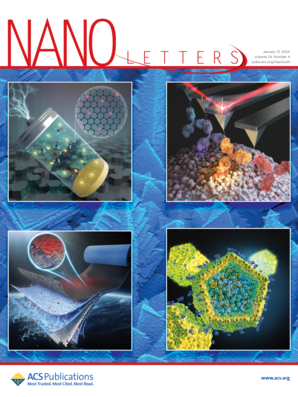Bioinspired Ruthenium-Porphyrin Electrocatalysts with Atomic N4/N2 Proximal Sites for Efficient Proton-Coupled Electron Transfer in Water Electrolysis.
IF 9.6
1区 材料科学
Q1 CHEMISTRY, MULTIDISCIPLINARY
引用次数: 0
Abstract
Mimicking the proton-coupled electron transfer (PCET) pathways of natural enzymes, we engineer a porphyrin-based ruthenium coordination polymer (Ru-PCPN) with precisely positioned atomic-level N4/N2 proximal sites through molecular-scale coordination engineering. This bioinspired architecture establishes a dual-site relay mechanism where the Ru-N2 center accelerates water dissociation kinetics while the adjacent Ru-N4 site optimizes hydrogen recombination. Experimental and theoretical results reveal that the sub-nanometer-proximate N4/N2 sites function as proton donor-acceptor pairs, enabling directional proton transfer via PCET and synergistically enhancing water electrolysis. When integrated with carbon substrates, the Ru-PCPN@CB catalyst demonstrates exceptional hydrogen evolution performance in alkaline conditions, achieving a low overpotential at 10 mA cm-2 (42 mV, comparable to 44 mV of Pt/C), high mass activity and TOF of 9.02 A mg-1 and 4.73 s-1 (∼7.0 and 3.6 times of Pt/C), and good stability. This work establishes atomic-scale coordination proximity as a new paradigm for breaking scaling relationships in multistep electrocatalysis.具有N4/N2原子近端位置的生物启发钌-卟啉电催化剂用于水电解中有效的质子耦合电子转移。
模拟天然酶的质子耦合电子转移(PCET)途径,通过分子尺度配位工程,设计了一种基于卟啉的钌配位聚合物(Ru-PCPN),该聚合物具有精确定位的原子级N4/N2近端位点。这种受生物启发的结构建立了一个双位点中继机制,其中Ru-N2中心加速水解离动力学,而相邻的Ru-N4位点优化氢重组。实验和理论结果表明,亚纳米近端N4/N2位点作为质子供体-受体对,通过PCET实现质子定向转移,协同促进水电解。当与碳衬底结合时,Ru-PCPN@CB催化剂在碱性条件下表现出优异的析氢性能,在10 mA cm-2时具有低过电位(42 mV,与Pt/C的44 mV相当),高质量活性和TOF分别为9.02 a mg-1和4.73 s-1 (Pt/C的7.0和3.6倍),并且具有良好的稳定性。这项工作建立了原子尺度的配位接近作为多步电催化中打破标度关系的新范例。
本文章由计算机程序翻译,如有差异,请以英文原文为准。
求助全文
约1分钟内获得全文
求助全文
来源期刊

Nano Letters
工程技术-材料科学:综合
CiteScore
16.80
自引率
2.80%
发文量
1182
审稿时长
1.4 months
期刊介绍:
Nano Letters serves as a dynamic platform for promptly disseminating original results in fundamental, applied, and emerging research across all facets of nanoscience and nanotechnology. A pivotal criterion for inclusion within Nano Letters is the convergence of at least two different areas or disciplines, ensuring a rich interdisciplinary scope. The journal is dedicated to fostering exploration in diverse areas, including:
- Experimental and theoretical findings on physical, chemical, and biological phenomena at the nanoscale
- Synthesis, characterization, and processing of organic, inorganic, polymer, and hybrid nanomaterials through physical, chemical, and biological methodologies
- Modeling and simulation of synthetic, assembly, and interaction processes
- Realization of integrated nanostructures and nano-engineered devices exhibiting advanced performance
- Applications of nanoscale materials in living and environmental systems
Nano Letters is committed to advancing and showcasing groundbreaking research that intersects various domains, fostering innovation and collaboration in the ever-evolving field of nanoscience and nanotechnology.
 求助内容:
求助内容: 应助结果提醒方式:
应助结果提醒方式:


